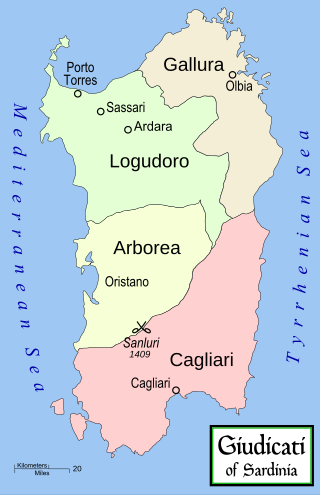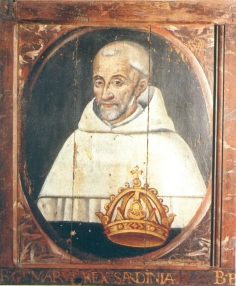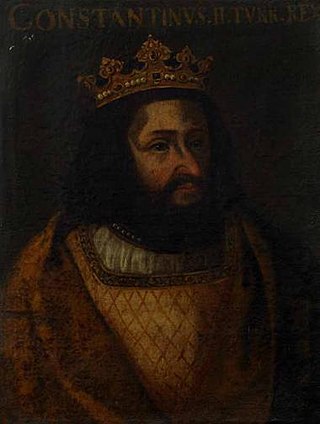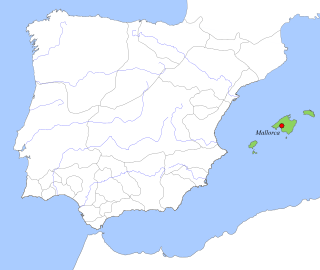Sources
- Caravale, Mario (ed). Dizionario Biografico degli Italiani: LVII Giulini – Gonzaga. Rome, 2001.
Ugo da Parlascio Ebriaco (died 30 May 1136) was a leading citizen in the Republic of Pisa in the early twelfth century.
Sometime between 1113 and 1115, Ugo and Pietro Moriconi, Archbishop of Pisa, led a successful expedition against the Balearic Islands. They stopped in Porto Torres on their return and it was there that they established relations with Constantine I of Logudoro.
Around 1128, Gonario II, Constantine's son, the child ruler of Logudoro, was brought to Porto Torres by his regent, Ittocorre Gambella, after an attempt to harm the child had been made by the Athen family. Porto Torres was then controlled by the Pisans, who whisked the child off to Pisa and the protection of Ebriaco. When Gonario turned seventeen, he married Ebriaco's daughter [1] and returned to Sardinia, with Pisan permission and four armed galleys. Ugo was part of this expedition to repossess the Logudoro in 1130. Together they landed at Torres and marched on Ardara, the location of the judicial palace, and took it. Controlling the giudicato again, they began construction of a castle at Goceano to guard the frontier.

Barison II or Barisone II was the giudice of Logudoro from 1153 to 1186. He was the son and successor of Gonario II, who retired to the monastery of Clairvaux to live out his days.

Comita III was the giudice of Logudoro, with its capital at Torres, from 1198 until 1218. He was the youngest of four sons of Barisone II of Torres and Preziosa de Orrubu. He ruled at a time when the great families, usually foreign, were superseding the giudici in power and influence on Sardinia.

Comita II was the Judge of the Judicate of Arborea, from 1131 until his death. He was the son of Constantine I of Arborea, first ruler of Arborea of the Lacon dynasty. He married Elena de Orrubu, mother of Barison II of Arborea. The dating and chronology of his reign are obscure.

Barison I or Barisone I was the judge of Arborea from around 1038 until about 1060 and then of Logudoro until his death sometime around 1073. He is the first ruler of Logudoro of whom we have any real knowledge. His whole policy was opposition to the Republic of Pisa and support of monastic immigration from mainland Italy. His wife was Preziosa de Orrubu.

William I, royal name Salusio IV, was the judike of Cagliari, meaning "King", from 1188 to his death. His descendants and those of his immediate competitors intermarried to form the backbone of the Italian Aristocracy, and ultimately their descendants in the Medici clan are precursors to, and definers of later royalty and claims thereto.

Gonario II was the giudice of Logudoro from the death of his father to his own abdication in 1154. He was a son of Constantine I and Marcusa de Gunale. He was born between 1113 and 1114 according to later sources and the Camaldolese church of S. Trinità di Saccargia was founded in his name by his parents on 16 December 1112, though it wasn't consecrated until 5 October 1116.

Comita Spanu was the giudice of Gallura, in Sardinia, from 1133 to 1146. He was the son and successor of Constantine II.
Constantine II was the giudice of Cagliari. He was called de Pluminus after his capital city.
Constantine I was the giudice of Logudoro. He was co-ruling by 1082 and sole ruler by 1113. His reign is usually said to have begun about 1112.

The Judicate of Cagliari was one of the four Sardinian judicates of the Middle Ages, kingdoms of Byzantine origins.

Constantine II, called de Martis, was the giudice of Logudoro. He succeeded to the giudicato sometime between 1181 and 1191. He was the son of Barisone II and Preziosa de Orrubu. His father associated him with the government in 1170 and abdicated the throne to him around 1186. His reign was generally characterised by contemporary chroniclers as "tyrannical."

The kings or judges of Logudoro were the local rulers of the locum de Torres or region (province) around Porto Torres, the chief northern port of Sardinia, during the Middle Ages.

The Judicate of Gallura was one of four Sardinian judicates in the Middle Ages. These were independent states whose rulers bore the title iudex, judge. Gallura, a name which comes from gallus, meaning rooster (cock), was subdivided into ten curatoriae governed by curatores under the judge. In the 13th century, the arms of Gallura contained a rooster.
Baldwin was a Cistercian monk and later Archbishop of Pisa, a correspondent of Bernard of Clairvaux, and a reformer of the Republic of Pisa. Throughout his episcopate, he greatly expanded the authority of his diocese, making it the most powerful institution in Liguria and Sardinia, and notably increased its landholdings.
Adelasia (1207–1259), was the Judge of Logudoro from 1236 and Judge of Gallura from 1238.
Ittocorre Gambella was the regent of the Giudicato of Logudoro between 1127 and sometime before 1140.
The Athen family was a noble family of Sardinia during the 11th and 12th centuries. It first appeared during the reign of Gonario I and was most prominent in the Giudicato of Logudoro.

Torchitorio III, born Peter, was the Judge of Cagliari from October 1163 to his deposition and arrest in 1188, after which he was never heard of again.
Saltaro was the son of Constantine I of Logudoro. His mother is unknown, it may have been Marcusa. Whether or not he is the same person as the "Saltaro de Gunale" pretender to the throne of Logudoro in 1127 during the reign of Gonario II is unknown.

In 1114, an expedition to the Balearic Islands, then a Muslim taifa, was launched in the form of a Crusade. Founded on a treaty of 1113 between the Republic of Pisa and Ramon Berenguer III, Count of Barcelona, the expedition had the support of Pope Paschal II and the participation of many lords of Catalonia and Occitania, as well as contingents from northern and central Italy, Sardinia, and Corsica. The Crusaders were perhaps inspired by the Norwegian king Sigurd I's attack on Formentera in 1108 or 1109 during the Norwegian Crusade. The expedition ended in 1115 in the conquest of the Balearics, but only until the next year. The main source for the event is the Pisan Liber maiolichinus, completed by 1125.